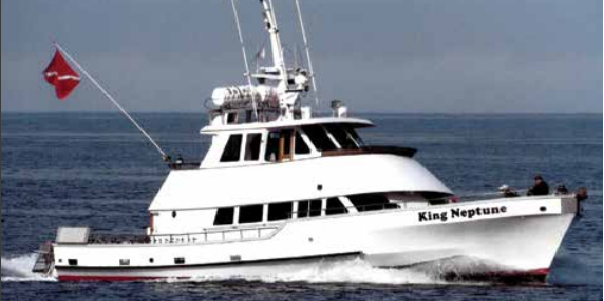NTSB investigation of the Grounding and Subsequent Breakup of Dive Vessel King Neptune is included in Safer Seas Digest 2015 to highlight how the lack of communication from the engineering staff to the vessel’s bridge team and pilots as well as the absence of specific procedures and training for emergency engine operations may lead to incident.
The incident:
On the evening of December 30, 2014, in severe weather conditions, the dive vessel King Neptune broke loose from its moorings in Avalon Harbor, Catalina Island, California. A harbor patrol officer, who later jumped on board the vessel to try to move it to a safe mooring location, died after falling into the water and becoming pinned between the vessel and a seawall. Under continuous wave action, the King Neptune broke apart and subsequently sank, resulting in a total loss valued at $1.5 million. Earlier that day, at 1412, the National Weather Service issued a small-craft advisory for the waters around Catalina Island. At the time, the advisory was issued the King Neptune was secured to a mooring buoy in Avalon Harbor.
The King Neptune owner told investigators that during the early afternoon he and the vessel’s part-time captain discussed the sufficiency of the vessel’s moorings. They decided to increase the number of mooring lines and have the vessel remain in the harbor rather than put to sea, or seek a more protected mooring location for the evening. At 1500, the King Neptune part-time captain reported for work at his second job as a patrol officer with the Avalon Harbor Department. He was assigned to work that evening as a deckhand on board patrol boat 3, along with two other harbor patrol officers.
About 2225, the King Neptune bow lines parted. The winds at the time were gusting to 39 knots, and the seas were 10–14 feet. When the crewmembers on board patrol boat 3 learned that the King Neptune had broken loose, they promptly proceeded toward the dive vessel and the parttime captain agreed to jump on board (or be the “jumper,” as harbor patrol officers would call a fellow officer boarding a vessel in this manner).
According to the other patrol boat deckhand, the King Neptune was still attached to two mooring buoys by its stern lines. The jumper boarded the dive vessel but did not take a radio with him or establish a communication plan (beyond shouting in the howling winds to the other patrol officers). He went below deck to start the engines but was unsuccessful in moving the vessel. The jumper then attached a towline from patrol boat 3 to the King Neptune bow; however, the line parted. About this time, the King Neptune stern lines also parted from their moorings. The dive vessel drifted into the harbor and approached the dangerous breaking surf near shore. After the jumper attached another towline to the King Neptune stern, patrol boat 3 began to tow the dive vessel. However, believing their boat was about to capsize, the patrol boat captain ordered the towline cut. Neither he nor the other patrol officer informed the harbor master’s office that one of their crewmembers was on board the King Neptune.
About 2245, the King Neptune drifted into the breaking surf near the shore. The jumper attempted to leap from the King Neptune onto the seawall on shore; however, he mistimed his jump and landed in the surf. Moments later, he was pinned against the seawall by the surging vessel and died as a result of his injuries. All that remained of the King Neptune after a night of pounding was a partially submerged hull and engines.
Neither the city of Avalon harbor regulations nor the Avalon harbor master had guidance addressing safe mooring in inclement weather. Also, no guidelines or formal training had been established regarding how Avalon Harbor Department patrol officers were to determine if a particular jump between vessels was safe, whether a patrol boat could tow a much larger vessel in high winds and rough seas, how to tow a vessel in severe weather conditions, or when and how to retrieve a harbor patrol officer from a vessel in severe weather conditions.
The National Transportation Safety Board determined that the probable cause of the breakup and subsequent sinking of the King Neptune was the failure of the vessel’s mooring equipment in severe weather conditions and the Avalon Harbor Department’s inability to prevent the vessel from drifting ashore. Contributing to the death of the patrol officer who jumped on board was the Avalon Harbor Department’s decision to allow personnel to board a drifting vessel in severe weather conditions without a plan for communication and retrieval.
Source & Image credit: NTSB






























































